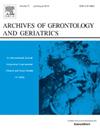Frailty and pre-frailty prevalence in community-dwelling elderly with multimorbidity: A systematic review and meta-analysis
IF 3.5
3区 医学
Q2 GERIATRICS & GERONTOLOGY
引用次数: 0
Abstract
Background
The relationship between frailty/pre-frailty, and multimorbidity in the elderly is recognized, but specific prevalence among community-dwelling elderly with multimorbidity is unclear. This study aims to determine these rates, analyze subgroup, and identify sources of heterogeneity to bolster evidence-based interventions and health policies.
Methods
We searched nine databases from inception to November 16, 2023, for cross-sectional and cohort studies on community-dwelling elderly with multimorbidity. Data were extracted to calculate the prevalence of frailty and pre-frailty. Study quality was assessed using AHRQ and NOS tools.
Results
Fifteen studies encompassing 9,683 participants with multimorbidity were analyzed. The pooled prevalence of frailty and pre-frailty was 18.1 % and 48.9 %, respectively. Age-stratified analyses found 17 % frailty and 58.4 % pre-frailty in the 70–74 age group, and 16.7 % and 54.2 % in those above 75 years. Cross-sectional studies showed 18.8 % frailty and 48.1 % pre-frailty, while cohort studies showed 18.1 % and 50.5 %, respectively. Asia had higher rates (22.7 % frailty, 43.5 % pre-frailty) than the Americas (9.9 % frailty, 56.3 % pre-frailty). By sample size, frailty prevalence was 21.3 % (<500), 9.1 % (500–999), and 17.9 % (≥1000), with pre-frailty at 51.1 %, 45.6 %, and 47.7 %. The FP method yielded higher prevalence estimates (17.7 % frailty, 51.6 % pre-frailty) than the FS method (9.5 % frailty, 39.2 % pre-frailty).
Conclusion
This study provides insights into the prevalence of frailty and pre-frailty among community-dwelling elderly with multimorbidity. Variations in prevalence rates may be attributed to differences in sample size and measurement tools, which also contribute to heterogeneity observed across subgroups.
多病社区居住老年人的衰弱和衰弱前患病率:系统回顾和荟萃分析
背景:老年人虚弱/虚弱前期和多病之间的关系是公认的,但在社区居住的多病老年人中的具体患病率尚不清楚。本研究旨在确定这些比率,分析亚组,并确定异质性来源,以支持循证干预和卫生政策。方法我们检索了9个数据库,从建立到2023年11月16日,对社区居住的多病老年人进行横断面和队列研究。提取数据来计算脆弱和预脆弱的患病率。采用AHRQ和NOS工具评估研究质量。结果15项研究共纳入9683名多病患者。虚弱和前虚弱的总患病率分别为18.1%和48.9%。年龄分层分析发现,在70-74岁年龄组中,17%的人虚弱,58.4%的人虚弱前,在75岁以上年龄组中,16.7%的人虚弱前,54.2%的人虚弱前。横断面研究显示衰弱率为18.8%,前衰弱率为48.1%,队列研究分别为18.1%和50.5%。亚洲的比率(22.7%衰弱,43.5%衰弱前)高于美洲(9.9%衰弱,56.3%衰弱前)。按样本量计算,虚弱患病率分别为21.3%(500)、9.1%(500 - 999)和17.9%(≥1000),而虚弱前患病率分别为51.1%、45.6%和47.7%。FP方法得出的患病率估计值(17.7%脆弱,51.6%脆弱前)高于FS方法(9.5%脆弱,39.2%脆弱前)。结论本研究揭示了社区居住老年多病患者的虚弱和虚弱前期患病率。患病率的差异可能归因于样本量和测量工具的差异,这也导致了亚组间观察到的异质性。
本文章由计算机程序翻译,如有差异,请以英文原文为准。
求助全文
约1分钟内获得全文
求助全文
来源期刊
CiteScore
7.30
自引率
5.00%
发文量
198
审稿时长
16 days
期刊介绍:
Archives of Gerontology and Geriatrics provides a medium for the publication of papers from the fields of experimental gerontology and clinical and social geriatrics. The principal aim of the journal is to facilitate the exchange of information between specialists in these three fields of gerontological research. Experimental papers dealing with the basic mechanisms of aging at molecular, cellular, tissue or organ levels will be published.
Clinical papers will be accepted if they provide sufficiently new information or are of fundamental importance for the knowledge of human aging. Purely descriptive clinical papers will be accepted only if the results permit further interpretation. Papers dealing with anti-aging pharmacological preparations in humans are welcome. Papers on the social aspects of geriatrics will be accepted if they are of general interest regarding the epidemiology of aging and the efficiency and working methods of the social organizations for the health care of the elderly.

 求助内容:
求助内容: 应助结果提醒方式:
应助结果提醒方式:


